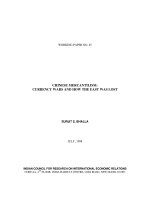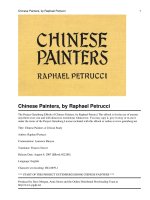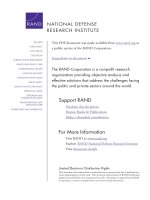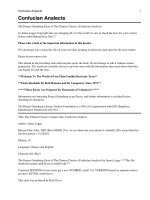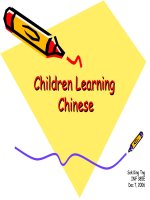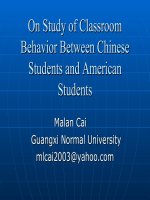What makes vietnamese so chinese
Bạn đang xem bản rút gọn của tài liệu. Xem và tải ngay bản đầy đủ của tài liệu tại đây (2.31 MB, 316 trang )
What Makes Vietnamese So
Chinese?
An Introduction to Sinitic-Vietnamese Studies
8/1/2007
Version 2.78
dchph
Tai Lieu Chat Luong
What Makes Vietnamese So Chinese?
/>An Introduction to Sinitic-Vietnamese Studies
DRAFT
dchph
Note: This paper is still virtually a draft. It is being edited extensively and will be updated
from time to time. I just started doing some serious editing, but I am still far from getting
ready to put up all the qouted sources together. I am to designate this round of editing
as version 2.78. for August 2007, so if you want to quote the material, please annotate
your quotations accordingly and check back again for more new update.
Also in this paper Unicode font is being used to display Vietnamese, Chinese, and other
IPA symbols. You may want to download it here Arial Unicode MS. (very large,
approximately 20 MB) to display all characters correctly as intended.
To make a query for a Chinese or Vietnamese word, you can always go to or to read and post your comments and questions, click here.
Page |2
What Makes Vietnamese So Chinese? 2007
Table Of Contents
Contents
dchph ........................................................................................................................................... 2
ABBREVIATIONS AND GLOSSARY ............................................................................................. 7
Introduction ................................................................................................................................... 12
I) ................................................................................................................................................. 13
A) Foreword: .............................................................................................................................. 13
B) The background .................................................................................................................... 18
B) Convention:........................................................................................................................... 21
1) The unconventional convention: ........................................................................................... 21
2) Symbols and conventions: .................................................................................................... 23
D) A revised course in the adaption of the reconstructed ancient sound values: .................... 29
E) Vietnamese and Chinese commonalities ............................................................................. 32
1) Modern dialectal similarities.................................................................................................. 32
2) The role of Mandarin ............................................................................................................. 41
II) THE CHINESE CONNECTION ................................................................................................ 45
A) Hypothesis of Chinese origin of Vietnamese ....................................................................... 46
B) Core matter of Vietnamese etymology ................................................................................. 54
III)............................................................................................................................................... 86
A) The underlined stratum of basic vocabularies : ................................................................... 86
Visual view of linked kinship of Vietnamese with other major linguistic families and their substrata .......................................................................................................................................... 87
B) Haudricourt’s theory of tonal development .......................................................................... 95
C) Correspondences in basic vocabularies revisited: ............................................................ 104
D) Similarity in cross-lingusistic-family vocabularies proves no genetic relation ................... 110
3|Page
1) Basic word lists at crossroads ................................................................................................ 111
IV) ............................................................................................................................................ 173
A) Sino-Tibetan etyma ............................................................................................................ 173
Sino-Tibetan with six divisions ................................................................................................ 173
Comparative lexemes in Sinitic, Bodic, Daic, Burmic languages: ............................................. 176
B) Problems in proving cognates of numerals ........................................................................ 202
B) The unfinished work ........................................................................................................... 215
E) Vietnamese and Chinese cognates in basic vocabulary stratum: ..................................... 222
1.
Family relations ................................................................................................................ 228
2.
Natural surroundings and phenomina ............................................................................. 229
3.
Spiritual beliefs ................................................................................................................. 232
4.
Plants, stables, foods, meats ........................................................................................... 233
5.
Body parts and anatomy .................................................................................................. 235
6.
Sensual and emotional acts and feelings ........................................................................ 236
7.
Daily and common activities ............................................................................................ 237
8.
Animals ............................................................................................................................ 240
Insects, pests, and parasites: ................................................................................................. 241
9.
Man-made objects and tools ........................................................................................... 242
10.
Most of functional words and grammatical markers (hưtừ 虛詞 xucí), indispensable in
the Vietnamese language ....................................................................................................... 243
V) ............................................................................................................................................. 250
A) In search of sound change patterns: .................................................................................. 250
B) An analogy of Vietnamese etymology: ............................................................................... 258
1) A corollary approach: .......................................................................................................... 259
•
"răng" ................................................................................................................................ 259
•
"mặt" ................................................................................................................................. 260
•
"cá" ................................................................................................................................... 261
Page |4
What Makes Vietnamese So Chinese? 2007
•
"lửa" .................................................................................................................................. 262
•
"gạo" ................................................................................................................................. 262
•
"đất" .................................................................................................................................. 263
•
"đốt" .................................................................................................................................. 264
•
con.................................................................................................................................... 265
•
sao.................................................................................................................................... 265
•
lá ....................................................................................................................................... 266
•
uống.................................................................................................................................. 266
2) Words of unknown origin: ................................................................................................... 266
3) Questionable words of Chinese origin: ............................................................................... 268
VI) CASE STUDY WORKSHEET: .......................................................................................... 270
Case study worksheet ............................................................................................................. 272
VII) A SYPNOPSIS OF PHONOLOGICAL SOUND CHANGES FROM CHINESE TO
VIETNAMESE: ........................................................................................................................ 276
VIII) .......................................................................................................................................... 290
APPENDICES ......................................................................................................................... 298
APPENDIX A ........................................................................................................................... 298
Examples of some polysyllabic and dissyllabic vocabularies ................................................ 298
I) Composite words: ................................................................................................................ 298
NOTE: ......................................................................................................................................... 299
II) Dissyllabic compound words: ............................................................................................. 300
NOTE: ......................................................................................................................................... 300
IV) Reduplicative dissyllabic and polysyllabic compound words:........................................... 300
NOTE: ......................................................................................................................................... 300
V) Polysyllabic "Vietnamized" English and French words: ..................................................... 301
NOTE: ......................................................................................................................................... 301
5|Page
VI) Some culturally-accented Vietnamese of Chinese origin: ................................................ 302
NOTE: ......................................................................................................................................... 303
APPENDIX B ........................................................................................................................... 303
APPENDIX C ........................................................................................................................... 303
Examples of some variable sound changes ........................................................................... 303
APPENDIX D ........................................................................................................................... 305
The case of "sông" .................................................................................................................. 305
APPENDIX E ........................................................................................................................... 308
The case of "chết".................................................................................................................... 308
APPENDIX F ........................................................................................................................... 310
The case of "ruồi" .................................................................................................................... 310
APPENDIX G .......................................................................................................................... 312
The case of "ngà" .................................................................................................................... 312
Page |6
What Makes Vietnamese So Chinese? 2007
ABBREVIATIONS AND GLOSSARY :
AC = Ancient Chinese (TiếngHán Thượngcổ 上古漢語)
Amoy = Fukienese or Fùjiàn (TiếngPhúckiến hay Hạmôn 厦門方言)
ArC = Archaic Chinese (TiếngHán Tháithượngcổ 太古漢語)
associative sandhi process = changes of sound of words as the results of
the assimilation of the sound or form of similar word in the same context.
Austroasiatic = Austroasiatic linguistic family (Ngữhệ NamÁ)
AV= Ancient-Vietnamese, also, ancient Việt-Mường (TiếngViệtcổ, TiếngVi
ệt-Mườngcổ)
B = Beijing dialect (thổngữ Bắckinh 北京方言)
Beijing = Beijing dialect (thổngữ Bắckinh 北京方言)
bound morphemes = the smallest meaningful phonological units that are
bound together and usually appear in pairs to form composite words
C = Chinese in general (TiếngHán 漢語) (See also: tiếngTàu)
Cant. = Cantonese (TiếngQuảngđông 廣東方言)
cf., or " §" = compare (sosánh)
character = mostly referring to a Chinese ideogram; also, a Roman letter
or a ideographic symbol (chữ, tự, mẫutự 字母, 漢字)
Chin., Chinese = Chinese in general (TiếngHán 漢語) (See also: tiếngTàu)
Chin. dialects, Chinese dialects = 7 major Chinese dialects, including subdialects (phươngngữHán, TiếngTàu 漢語方言)
Chaozhou (Chiewchow) = a sub-dialect of Fukienese, also known as
Tchiewchou (tiếngTriều, tiếngTiều 朝州方言)
composite word = two-syllable word that is composed of two bound
morphemes of which either one of them cannot function fully as a word (từ
kép, từ songâmtiết)
compound word = two-syllable word that is composed of two words (từghé
p, từ songâmtiết)
7|Page
doublet = A Chinese character of the same root that appears in different
form (từđồngnguyên 同源辭)
diachronic = concerning historical development of language of something
through time
Dai = T’ai, Tai, Tày, and sometimes Thai, languages (TiếngTày 傣語)
ex. = example (= td. 'thídụ')
dissyllabics = Charateristics of a language based on its dominant twosyllable words in its vocabulary (tínhsongâmtiết 雙音節性)
EM = Early Mandarin
EMC = Early Middle Chinese (TiếngHán Tiềntrungcổ 前中古漢語)
Fk = Fuzhou, Fukienese (Fùjiàn) or Amoy (TiếngPhúckiến hay phươngngữ
Hạmôn 厦門方言)
FQ (or Pt) = 'fănqiè' 反切 phiênthiết (initial and syllabic conjugation, a
Chinese lexical spelling)
Hai. = Hainanese, a sub-dialect of Fukienese or Amoy (TiếngHảinam 海南
方言)
HN = Nôm words, or Vietnamese words, of Chinese origin (HánNôm 漢喃
辭匯)
ideograph/ideogram = a written symbol of language writing system
developed from graphic representation (chữtượnghình 形像字母)
"iro" (or #) = in reverse order (nghịchđảo thứtự từ)
IPA = the International Phonetic Symbol (Phiênâm Quốctế)
K, Kh. = Khmer or Cambodian (Tiếng Caomiên)
Kinh / NgườiKinh = literally "the metropolitans", or "the Kinh", meaning the
Vietnamese majority ethnic group living in the coastal lowlands as
opposed to "NgườiThượng" ("the Montagnards") which denotes minority
ethnic groups living in remote highlands in Vietnam (京族)
Latinized / Latinization: same as Romanized / Romanization (Latinhhoá 羅
丁拼音)
Page |8
What Makes Vietnamese So Chinese? 2007
loangraph = A loangraph in Chinese is a homophone connveying a
different meaning but using the same ideographic character (giảtá, 假借)
LZ = Late Zhou, L. Zhou (Cuối ÐờiChâu 周末)
M = Mandarin, QT (TiếngPhổthông, tiếngQuanthoại 普通話, 國語)
Malay = Malay linguistic affinity (Ngữchi Mãlai 馬來語支)
Mao-Nan = Mao-Nan language, a Mon-Khmer language spoken by MaoNam ethnic group in Southern China (TiếngMaonam 毛南語) MC = Middle
Chinese (TiếngHán Trungcổ 中古漢語)
MK = Mon-Khmer linguistic affinity (Ngữchi Mon-Khmer)
monosyllabics = Charateristics of a language based on its dominant onesyllable words in its vocabulary (tínhđơnâmtiết 單音節性)
N = Original Vietnamese, also old Chinese-based Vietnamese wrting
system
(từ Nôm, tiếngNôm hoặc từ thuần Việt 純喃辭匯, ChữNôm "字喃")
Nôm= Nôm characters, an old Chinese-character bases Vietnamese
writing system, or in expanding meaning Nôm words, HN (HánNôm),
Vietnamese words, of Chinese origin (HánNôm 漢喃辭匯)
Nùng = Zhuang language, same as Ðồng, Tráng (TiếngNùng 莊語, 垌語)
OC = Old Chinese (TiếngHán Cổ 古漢語)
OV = Old Vietnamese form (TiếngViệt cổ / TiếngViệtMường cổ)
Pt = FQ 'fănqiè' 反切 phiênthiết (initial and syllabic conjugation, a Chinese
lexical spelling)
Pinyin = People's Republic of China's official Romanization transcription
system of Pǔtōnghuà (pinyin haylà phiênâm 拼音)
polysyllabism = Charateristics of a language based on its dominant multisyllable words in its vocabulary (tínhđâmtiết 多音節性)
Pre-SV = pre-Sino-Vietnamese (TiềnHánViệt 前漢越辭匯)
Pro-C = proto-Chinese (TiếngHán Tiềnsử 前史漢語)
Putonghua or Pǔtōnghuà = Official name of Mandarin (Tiếngphổthông
haylà Quanthoại 普通話/國語)
9|Page
PV = proto-Vietnamese, proto-Vietic (TiếngViệt Tiềnsử)
radical = basic Chinese ideograpghic root on which other characters are
built (tựcăn 語根)
Quốcngữ = Vietnamese national orthography
Romanized / Romanization: same as Latinized / Latinization (Latinhhoá 羅
丁拼音)
synonymous compound = compund word that is composed of two
synonymous syllables or words (từghép đẳnglập, từkép đẳnglập, từ
songâmtiết đẳnglập)
sandhi = change of sound of word under the influence of a preceding or
following sound
sandhi process of assimilation / association = same as the associative
sandhi process
synchronic = studying language as it exists at a certain point in time,
without considering its historical development
Sinicized or Siniticized = influenced, characterized, and/or identified by
Chinese elements
ST = Sino-Tibetan (HánTạng 漢藏語系)
SV = Sino-Vietnamese (HánViệt 漢越辭匯)
Tchiewchow = a sub-dialect of Fukienese, also known as Chaozhou (tiế
ngTriều, tiếngTiều 朝州方言)
Thượng / NgườiThượng = See: Kinh/NgườiKinh
TiếngTàu = a slight degrading term to connote the Chinese languages, of
which the term "Tàu" could have been originated from Tần 'Qín 秦' or tiế
ngTiều 朝州方言 (từ "Tàu" cóthể do "Tần" hoặc tiếngTiều 朝州方言 màra.)
V, Viet. = Vietnamese (TiếngViệt 越南話)
"Vietnamized" = Characterized by the localization of loanwords to fit into
Vietnamese speech habit (Việthoá 越化)
VM = Việt-Mường form (TiếngViệtMường 越孟語)
VS = Sinitic-Vietnamese (HánNôm 漢喃辭匯)
P a g e | 10
What Makes Vietnamese So Chinese? 2007
Zhuang = the Zhuang language, same as Nùng, Ðồng, Tráng (TiếngNùng
莊語, 垌語)
xXx
11 | P a g e
Introduction
Originally this paper is entitled Introduction to Sinitic-Vietnamese Studies. What I had
initially in mind is to introduce some new findings in the study field of the Chinese (C,
Chin.) origin of a vast little-known stock of the Vietnamese (V, Viet.) vocabulary, which
is to be called the HánNôm, or Sinitic-Vietnamese (VS, Nôm).
During the course of putting things together, I have to reconcile myself with the fact that
in the Asian linguistic circle philologists seem to be strongly in favor of the Mon-Khmer
(MK) origin of the Vietnamese language with a wide-range basic words in V that appear
to be in agreement with those of MK languages. Interestingly, by doing so they are not
aware that many of those V etyma related to those in Chin. one way or another as they
are cited in this paper.
For the change of the title of this work into What makes Vietnamese so Chinese? I find
it deemed to be much more appropriate for what will be put in discussion in this paper
that will refect the substantial findings of massive V etyma that resemble those of Chin.
so much that they could still shed doubts on the MK theory. For such reason, main
points of my discussion about the Chin. factors in the V language still remain the same
insofar as V and Chin. are concerned, etymologically.
These newly identified words of Chin. origin are direct results of applying two
etymological methods called dissyllabic and analogical approaches. The first one is to
treat sound changes of two-syllable Chinese words to Vietnamese as being unrestricted
to and independent of individual one-syllable words to identify multiple patterns of sound
changes that have occurred to the same syllable in polysyllabic Chinese lexicons in the
process of their natural adaption in Vietnamese. This method, in turn, will help analogize
sibling glosses within a categorical group and in a cultural context, i.e., if a word has a
Chinese origin, chances are that its related words could be the same, too, which would
go unnoticed otherwise. This subsequent methodology is called the analogical approach.
P a g e | 12
What Makes Vietnamese So Chinese? 2007
By applying these two new etymological approaches, more Vietnamese words of
Chinese origin, including those of basic vacabulary stratrum, can be unveiled.
Implications of any new development in this study can be used to rebut the arguments
that the origin of Vietnamese is of the Mon-Khmer branch of the Austroasiatic linguistic
family. In addition, evidences on Chinese linguistic traits found in this study, therefore,
may eventually help strengthen the foundation for re-classifying Vietnamese into the
Sino-Tibetan (ST) linguistic family.
In the meanwhile, even though the HánViệt, or Sino-Vietnamese (SV), sound system,
obviously a variation of Middle Chinese (MC), is not the subject matter under discussion
in this study, its sound change patterns and rules are also utilized here.
I) INTRODUCTION:
Before I go into discussion of the main subject, I would like to introduce a sketch of the
main points made in this study, along with the background underlining a compelling
motive that has drawn me to do this research, the goal I wish to achieve, then I will
define some terms and explain the conventions, abbreviations, and symbols used here.
This paper is intended for both linguistic specialists and general readers as well, so
please bear with me should I explain too much of anything, which is so obvious to
specialists in the field study, or too little of everything, which general readers will find it
difficult to follow.
A) Foreword:
I am well aware that today's belief in the linguistic world is going strongly more for
theories of Mon-Khmer (MK) root in the Austroasiatic linguistic family (ALF) for the origin
of Vietnamese than for those of older Sino-Tibetan (ST) camp. However, bear in mind
that current hypotheses about the Mon-Khmer genetic affinity of Vietnamese is still only
another theory, an unfinished work, not quite satisfactorily proven yet. In this
circumstance, the Sino-Tibetan school of thought is still holding ground for its prior
13 | P a g e
theoretical merits, still worth being recapped and explored further because there are
equally solid linguistic evidences pointing to that direction.
In studying the Vietnamese language as it appears in its wholeness, in terms of its
linguistic characteristics and traits, actually it doesn't matter much whether initially it was
originated in the Mon-Khmer linguistic sub-family or not(1) but all it counts is what
makes it up as a living language as it appears today with all the attributes considered as
natural parts of a language. Analogically, the English language can be regarded as such
a case, that is, when we look at this language, we see the language presents itself in its
wholeness, not just only the Anglo-Saxon parts of it. Similarly, Vietnamese is a
language that has blended itself beautifully with all Chinese elements that are impartible
and one can see in it neither only those common peculiatiries nor solely Mon-Khmer
traces of a limited amount of their etyma. The same holds true for those of other
languages in the Austroasiatic family such as Munda despite of the fact that one can
find a certain amount of basic glosses between the two languages and that does not
make Munda even a distant cousin of Vietnamese.
The fact that, as presented in this paper, the nature of linguistic attributes of Vietnamese
is so similar to Chinese in most of the aspects that make what a language of the SinoTibetan linguistic family (STLF) look like should also make Vietnamese a class of the
same linguistic family. For this reason, sidelining the main objective to prove the
Chinese origin of thousands of Vietnamese words, this study is also an attempt to
answer the question: "Is the Vietnamese language is characteristically much closer to
the Chinese language than to a Mon-Khmer language such as Khmer?" This research
will demonstrate that it is much more like Chinese, which is so obvious, above anything
else, e.g. grammar, grammatical markups and instrumental prepositions, tonal system,
phonology, peculiar experessions, and, especially, monosyllabic stems and lexical
compositions from the same etyma which make up a vast amount of Vietnamese words,
which, at first sight, seem to be "pure" Vietnamese, or indigenous, but actually in most
cases might have Chinese origin.
P a g e | 14
What Makes Vietnamese So Chinese? 2007
By taking the dissyllabic and analogical approaches suggested in this paper, you will
see how thousands of more Vietnamese vocabularies can be positively identified, which
undoubtedly have been either missed or neglected in the field of Vietnamese historical
linguistics up to date from the day those Vietnamese specialists have started
abandoning the Sino-Tibetan ship and jumping on the Austroasiatic bandwagon since
the later half of the last century.
In the meanwhile, for the term "the Austroasiatic linguistic family" (ALF) I will identify it
with linguistic roots of many indigenous languages being spoken by many ethic groups
of the Yue (Yueh, or BáchViệt) descendants, also kown as the Yues as termilogically
mentioned in Chinese ancient historical records, who are still living in the Southern part
of China today, including the largest Zhuang (Nùng) minority whose language is
universally classified as that of the Sino-Tibetan linguistic family, not to mention several
other ethnic groups currently living in those mountainous regions of North Vietnam, in
Laos, as well as the peoples of Daic origin in today's Thailand. Those facts will
eventually bring us to converge other notions that all ancient Yue dialectal speakers did
have common ancestors, who have sometimes been referred to as "the larger Proto-Tai
(or Pre-Tai) indigenous stock" that might have split up into many distinct ethnic goups
such as Zhuang or Dai as best known in our era. Aboriginals of this stock might have
lived in the habitats which in ancient times used to embrace a vast region below the
Yangtze River, east and south, all the way to the surrounding seas. Notably, Proto-Tai
people coud also have been the ancestors of the Zhou's Kings, as having been long
speculated by many renown East Asian historians. They had not only made up the
ethnic composition of citizens -- possibly with the exception of those of the Qin State if
we equate them with "the Proto-Chinese" -- of the states of Chu, Qi, Jin, Yan, and Han
in the Six States in the Warring Period, that in the later time all merged with the Qin's
populace to become "the mixed-stock Chinese", but also, at the same time, further
broken down into smaller tribal groups and finally evolved into ethnic diversities, hence
the Yue peoples as later appeared in Chinese historical records, over the span of many
thousand years prior to the unification of a vast pre-China's empire ruled by Qin
15 | P a g e
Shihuang of the Qin Dynasty, of which all the Qin's citizens in the melting pot of the first
unified emprire had become "the Early Chinese" of the later Middle Kingdom in periods
following the rise of the Han Dynasty. Those Yues who could have not withstood the
process of integrating forces of the Han culture fled to mountainous regions. Over the
time their forced migratory and fleeing paths had been pushed further southwards into
the aforementioned areas and became what they appear at the present time.
(Interestingly enough, similar scenarios repeated again exactly the same process that
had happened to both those indigenous peoples and migrants who had previously lived
or already long resettled in the Northern part of today's Vietnam around the Red River's
delta regions when the "composite Han" -- or "the Early Chinese", the Chinese in Han
Dynasty from many regions of those states which had fallen under the umbrella of Qin
Dynasty in the previous period -- armies came to invade, including those war-savaged
immigrants to follow later. Once having reached the new territories those Northerners as
conquerers mostly had resettled there forever. Undoubtedly their offsprings over the
time had numerously multiplied and give birth to next generations. Again, all could have
mixed up with the indigenous people, who in turn would have possibly intermarried with
other waves of those mixed-stock Chinese immigrants from the China-North (華北
Huabei) and -South (華南 Huanan) who have come later throughout the next two
millenia until our time to form the new "Kinh", ie. Vietnamese, group.) Under such
historical circumstances, languages in "the Austroasiatic linguistic family" had been
formed out of Pro-Taic languages around 3000 years ago, long before the emergence
of the Zhou Dynasty. In other words, on the one hand they all had been stemmed from
an ancestral Proto-Taic linguistic form supposedly spoken by the so-called "larger
Proto-Tai indigenous people" and finally evolved themselves into linguistic forms of the
Yues including those spoken by the Zhuang, the Dai, etc. while, on the other hand, they
had branched off to become other languages included in what is now commonly known
as the Austroasiatic linguistic family. Furthermore, during the reigns of Zhou's Kings
Proto-Taic glosses had also found their way into, intertwined and interpolated, and
merged with the Archaic Chinese, also known as Ancient Chinese, that had come a
long way since its break-off from the Sino-Tibetan route and evolve itself independently.
P a g e | 16
What Makes Vietnamese So Chinese? 2007
(See Brodrick, 1942. Norman, 1988. Wiens, 1967. FitzGerald, 1972) Variants of this
early form of old Chinese later had followed the Han soldiers and emigrants to go south
all the way to Annamese ("Tonking") regions and have blended well gradually with the
Proto-Vietic language.
This concept of "Austroasiatic", therefore, is only implicitly used in this paper, which is to
be often referred to as "the Yue languages" with the implication that this terminology
does not include the Mon-Khmer languages in the direct sense of affinity that the
ancestral Vietnamese as Proto-Vietmuong had emerged and formed from them even
though, they, as a whole, constitute another sub-family in the larger Austroasiatic
linguistic family as commonly referred to by modern linguists. That is to say, in this
paper Austroasiatic languages may mean the same thing as the Yue languages and this
implication inevitably will put Vietnamese in line with popular theories that it originally
had started out from a common Austroasiatic linguistic root. It is so because they had
actually broken off from the "Proto-Daic" mainstream long before the Proto-Vietmuong
formation. Under this perspective, hence, the only difference is that the Mon-Khmer
languages are not included in this classification since they are not in synchronic
connection with the Sinitic scope we are investigating under which Chinese elements
are seen to have been adopted and their materials used profusedly and vehemently to
nurture genesis of a new form of speech built around the Proto-Vietic core largely by
illiterate common popupace from all walks of life. Both Daic and Archaic Chinese strata
in Vietnamese solidly support that point of view.
Nothing is contradictary about this idea if we take into consideration that Chinese and
Tibetan, despite of their affinity, are two completely different languages, just like the
Vietnamese and Mon-Khmer languages. Nonetheless, in the case of Vietnamese and
its becoming, the so-called indigenous Proto-Vietmuong language originally spoken by
those people living in the Delta of the Red River began to have split up into those of
Proto-Muong, to have gone with those Muong groups who fled into the mountainous
regions, and Proto-Vietic, with a much further fusion with what appears to be variations
of Ancient Chinese brought in by the Han invaders accompanied by new settlers, to
17 | P a g e
have been spoken by those who stayed behind and integrated with Han expansionists
and then their descendants as well as many more other "composite Chinese" who came
later waves after waves. Again, many remnants and residues of Ancient Chinese still
exist in modern Vietnamese allow us to see the matter as such. From that time on the
Vietnamese language has been developed and evolved around the Chinese linguistic
cores, though characteriscally unique and separate due to the habit of people's speech,
that seem to be a parallellism of the origin and evolution of Zhuang or Tai languages,
which are firmly classified as those of Sino-Tibetan linguistic family.
Regarding to the Mon-Khmer origin of the Vietnamese language, what has been
discussed to date prior to this study mostly has been based on claims that certain
Vietnamese basic words correspond to those basic glosses scatteringly dotting
throughout many Mon-Khmer languages, a majority of which, amusingly enough, turns
out to be cognate to those of Chinese (so then reasonably a question can be asked:
who had borrowed those words from whom?) However, the question of whether those
arguments on the matter of Mon-Khmer affinity of Vietnamese are still valid or not after
examing the findings presented in this research is open for further discussion and
investigation.
B) The background:
How have I gone about this etymological affair? Admittedly I am no Vietnamese
historical linguist by training whatsoever except for having taken those linguistic courses
taught by Professor Nguyễn Tài Cẩn and Profressor Hoàng Tuệ in the School of Letters
of Saigon University back in the late 1970's. In my spare time, however, I simply have
been lucky enough for having been exposed to the Chinese language in some scholarly
fields for quite a time. The encounter with the Chinese historical linguistics over the
years has aroused inside me a curiosity for the Chinese linguistic past and that
experience, analogically the same as that of English learnera who know well the Latin
and other Roman languages, has widened my knowlege of the Chinese etyma and
Vietnamese etymology of Chinese origin. Hence from there has my conviction of the
P a g e | 18
What Makes Vietnamese So Chinese? 2007
Sino-Tibetan connection, in the sense that all other variants of the Yue languages being
regarded as of the same linguistic family, grown much more firmly. For this matter, in
the end of this research paper you will find a long list of the bibliography, that I have
read word by word -- not just by excerpts for the purpose of citing quotations to support
my arguments -- over the past twenty some years, that has led me into such belief. Also,
I will try to identify as many related resourceful linguistic websites as possible which I
will readily admit I have only skimmed for related information, but not deliberately read
them as those in print. Even though the electronic forms have proven their superior
strength, the problem of their reliabilty and durability lies in the fact they are in constant
changes as their authors see fit and that down the line for the next 20 years, who knows
how many of them will still be around and available as they are today in the cyberspace
for interested readers to refer to just in case. (Please try to find any cited sources no
longer existant in ).
Anyway, being totally so fascinated by this subject I have spent enormous time teaching
myself Vietnamese and Chinese and their historical linguistics and been compelled to
explore the ideas of tracing etymological proofs for many Nôm (N) words of Chinese
origin. Metaphorically, just like a pilgrim who is in constant search for sacredly spiritual
revelation in his or her life, in this etymological expedition I have unexpectedly stumbled
upon hitches and hits in the ancient world of Chinese linguistic sound bits, for which I
have jotted down in the old-fashioned index cards, and discovered a whole picture of
the Vietnamese etymological structure and essence. Indeed, I have finally come to
terms that the Vietnamese and Chinese languages have so much more similarities,
even more than what they share among the Sino-Tibetan languages themselves, than
those of any other Mon-Khmer languages as have been suggested so far that they all
were originated from the same root as that of Vietnamese. It is from this conviction that I
have begun sorting things out, literally out of my index cards that are numbered 20,000
plus, and now I am in the process of gathering supporting arguments to nurture my
hypothesis that most, if not all, Vietnamese words have a Chinese origin and,
19 | P a g e
sometimes, for those basic vocabularies, they appear to be cognate to those of Chinese,
that is, both from the same root.
In the process of working on this project, to be specific, I have recorded substantial
findings and have started to theorize them and I will, gradually, post them on the
internet as I am progressing. This is the goal I am determined to pursue by setting forth
the new linguistic expedition going for the Sino-Tibetan direction since I view language
as a living thing as what actually appears to me with all its characteristics other than
what originally was from start, let's say, ten thousand years ago. With the results found,
with its genetic affinity proven valid or not, Vietnamese will probably once again be
reconsidered and reclassified as a language that belongs to the Sino-Tibetan linguistic
family given the common linguistic peculiarities existant in both Vietnamese and
Chinese.
The benefits, accordingly, from such classification come from the fact that it will enable
us to approach Vietnamese historical linguistics from a much different and wider
pespective by being able to access plenty of research tools and accompishments in
Chinese linguistic studies made avalable to us to apply not only in Vietnamese historical
linguistics or etymology, but also in various fields of Vietnamese studies as well, such
as Vietnamese anthropology and archeology regarding the origin and biological
composition of Vietnamese people and their nation.
It is possibly so as we all have known, most largest linguistic institutions on earth all
have devoted and invested a large amount of resources and expertise in the field of
studying the Chinese linguistics, so those benefits are foreseeable, for instance, any
progress in any fields of Chinese linguistics can be equally applied to Vietnamese
research without much reservation. Applicably, the same cannot be done much with
those achievements in the fields of studies of the Mon-Khmer languages. Let's say,
Chinese is now treated as a polysyllabic language and that linguistic characteristic has
faithfully reflected in its "pinyin", or romanized Chinese transcription system, so should
P a g e | 20
What Makes Vietnamese So Chinese? 2007
be the Vietnamese orthography in the context of attempting to reform its current
inefficient monosyllabic writing system.
Lastly, as to my goal as stated from the outset, hopefully my final work will also give the
Vietnamese etymology this kind of fresh perspective with concrete results with which
future lexicographers will make use of to corporate them into a Vietnamese dictionary
with all etymological list for each word, which a Vietnamese dictionary has never had
before.
B) Convention:
1) The unconventional convention:
The unconventional technical approach taken in the writing of this paper is that there will
not be a whole section to be devoted to listing all the rules of sound changes, natural or
unnatural, from Chinese to Sinitic-Vietnamese as one usually would expects, but only a
synopsis will be provided in the last section. The reason is that, firstly, that is
tantamount to a complicated task since the sound changes patterns have occurred
somewhat rather unsystematically and unnaturally, not in batches and shifts and drifts
as in the case of the Sino-Vietnamese sound system which has been quite well
documented (see Nguyễn Tài Cẩn, 1979, 2001). The sound changes did happen,
though. Throughout the examples cited in this research you will see that Chinese words
have infiltrated the Vietnamese vocabulary continuously since the ancient time in
different periods and, concurrently, from a viariety of Chinese dialects colloquially,
including Mandarin seen as official language of imperial courts of China throughout its
history including those of dynasties after Vietnam gained it independence in the 10th
century. If my work will later on prove to be of high value, some specialist in
categorization will help systemize and catalog all the possible sound change rules
accordingly.
21 | P a g e
Secondly, this research, for the time being, should be treated only as a demonstration of
how the application of my two new etymological approaches have been utilized and how
their yielded results have come about throughout the whole process in finding the
Vietnamese words of Chinese origin, which I call the Sinitic-Vietnamese (VS).
Accordingly, the underlined rules of phonological changes by no means can be treated
as a complete reference manual because this research, as a matter of fact, is still an
on-going work that is constantly being edited and modified in the years to come.
Thirdly, as a result, the methodologies utilized here are more suggestive than definite
and, unless stated otherwise, they always should be considered and used only as
etymological tools, among others, to explore tentative rules of sound changes from one
word to another, that is, what changes into what or how it has happened.
Lastly, it would become a long and boring paper as I have seen in many works if we just
cite long list of rules of sound changes instead of focusing on exploring interesting case
studies and discussing about the process of how to draw a conclusion of sound
changes for specific newly-discovered words found to be of Chinese origin. By doing so,
in the end you can learn how to do the same yourself after understanding how I have
manipulated my approaches to reach certain conclusions. Therefore, sound change
rules will be discussed only in a scattering, but not sparingly though, manner throughout
this paper, that can be found in any sections or paragraphs, as needs arise when a
demand for explanation of how the final sound changes have actually occurred and
which could be only applicable and limited to certain cases and why they did not occur
to the other sounds of the same nature. Again, the important thing is to let you
understand how the sound changes have occurred in certain ways either by linguistic
rules or just a matter of speculation. Similarly, you can learn to apply the same
approaches yourself just as I have done.
P a g e | 22
What Makes Vietnamese So Chinese? 2007
2) Symbols and conventions:
In this paper I will use both common conventions utilized in the fields of historical
linguistics and some uncommon signs and symbols of my own. The reader should
already be familiar with some commonly used linguistic symbols, the International
Phonetic Symbol (IPA), and Vietnamese (V) orthography (Quốcngữ) (2). Abbreviations
will be noted once when they first appear. Examples within a paragraph will be wrapped
to the next separate line and numbered or bulleted ( ) for better illustration. Also, in
most of the cases, there may be lengthy comments about patterns of sound changes
and evolution of those Vietnamese words under scrutiny, to be put in between square
brackets as [xxx yyy zzz ], as how they have come about in order to support arguments
about the Chinese origin of those words. After all, that is the purpose of this
etymological research.
English meanings will be noted once after each word and by no means exhaustive.
Sometimes they will be omitted if deemed irrelevant. The commonly used symbols
include
“>” denoting “evolves into” (diachronically),
“<” sign “derived from” (diachronically),
“=>” “giving rise to” (by a phonetic rule),
“~>” “giving rise to” (by analogy),
“<=” "built with",
“~” “alternating with” or "is cognate to" (synchronically),
"$" for literarary use only, as opposed to a vernacular or colloquial form
"#" in reverse order ("iro"),
"@" associated with, identified with, assimilated with ("liêntưởng", "đồnghố")
"©" archaic, old usage, obsolete
"đ" contraction, sound dropped or deleted
"Đ", cf., compare
"ả" pattern of sound change
23 | P a g e
"%" possible alternate
"&" in combination with
"/" under the condition of, being conditioned by,
"\" alternatively, under the influence of,
"[xxx]" exact phonetic value, else, indicating an insertion to further explain the
case under discussion,
"/xxx/" approximate phonetic value,
/ã/, /ẽ/, /õ/... nasalized vowels,
"X- , -Y-, Z-" capital letters signify arbitrary consonants of similar class of
articulation in phonetic transcriptions,
"=" equal to,
"(?)" unidentifiable or unknown element or source,
"|" "syllabic divider" or "hononymous or parallel elements", also, a separator
"{x- ~ y-}" and/or "~" sound change patterns, also, being conditioned by
“*” and “**” hypothetically reconstructed (* ancient – denoting the AD period to the
Middle Age – and ** archaic, Proto- form – BC and maybe dated as far back as to
the pre-historic age) sound”.
Since the resemblance of both Vietnamese and Chinese in terms of linguistic traits, to
be discussed later through this paper, in many a case is closer than those of many
Sino-Tibetan languages as they appear to Chinese, I will use the term SiniticVietnamese (VS) or the HánNôm, including Nôm (supposedly indigenous or "pure", but
actually not, Vietnamese words), to signify the Chinese linguistic attributes that exist in
those Vietnamese words, mostly, of Chinese origin. It is because for those etymons
under investigation the Vietnamese counterparts of those Chinese roots are mostly
conformable to those phonetic, phonological, semantic, syntactical, lexical, and other
linguistic peculiarities such as the tonal system that exist in the Chinese language.
Accordingly, the term "Sinitic-Vietnamese Studies" is chosen to denote those fields of
studying common linguistic traits shared by both Chinese and Vietnamese and
approaches to research the Vietnamese etymology of Chinese origin. Awaiting further
studies to be done, neither term necessarily means proven genetic affinity between the
P a g e | 24
What Makes Vietnamese So Chinese? 2007
two languages, equally applying to other Sino-Tibetan languages, even though
obviously they imply a linguistic classification. For now it should be considered only as a
mere suggestion that, with all of its little-known “Sinitic”, or Chinese, pecularities,
Vietnamese may belong to Sino-Tibetan or, probably a new classification to be created,
a Sinitic sub-division in the Sino-Tibetan language family.
In the lexical aspect, in contrast with Sinitic-Vietnamese is the term Sino-Vietnamese
(SV), or HánViệt. It is commonly used mostly to refer to the systematic Vietnamese
pronunciation of massive Chinese vocabulary essentially used in modern Vietnamese.
Analogically Sino-Vietnamese words are just like those of Latin or Greek origin in
English. There is a consensus that Sino-Vietnamese is a slight variation of Middle
Chinese (MC) sounds. Sometimes the term Sino-Vietnamese loosely embraces some
other variants of Sino-Vietnamese lexicons found in the Old Chinese (OC) (also called
Archaic Chinese (ArC)), the Ancient Chinese (AC) (sometimes called the Early Middle
Chinese (EMC)) loanwords or Tiền-HánViệt (“the Pre-Sino-Vietnamese” (Pre-SV)), and
their variants in Vietnamese which sometimes dated as far back to the Proto-Chinese
(Pro-C) source, for instance,
•
(1) bụt, (2) Phật, (3) vãi 佛 Fó (Phật) [ M 佛 fó < MC but < *OC bjət | %@ OC
*phjət > MC phut > M fó, | Buddha (from Sancript) | VS Bụt > SV Phật | Cant. : fat
42, Wenzhou : vai42, ] : Buddha, buddhist, buddhist monk,
•
(1) vợ, (2) phụ, (3) bụa 婦 fù (phụ) [ M 婦 fù < MC bjəw < *OC bjəʔ] : wife, lady,
woman,
•
(1) chài, (2) lưới, (3) chàilưới, (4) là 羅 luó (la) [ @ & 羅 luó (la) + 羅 luó (lưới) | M
羅 luó < MC lɑ < OC *jraih ] : fish by net, bird-net, net,
•
(1) cộ, (2) xe, (3) xecộ, (4) cỗ, (5) cỗxe : 車 chē (xa) [ @& 車 chē (xe) + 車 chē (c
ộ) ~ M 車 chē, jū < MC kʊ < OC *kla | Note that "cỗxe" could also be orginated
from Cantonese 架車 /kache/. | According to Starostin, in MC 車 also read tʂa,
FQ 尺遮 (whence Mand. chē, Viet. xa), but this reading is rather recent (judging
from rhymes, not earlier than Eastern Han) and must stem from some Old
25 | P a g e

